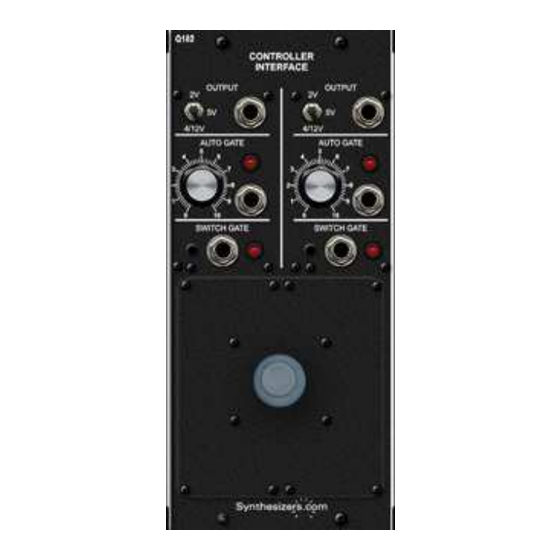
Advertisement
Quick Links
Q182TS
ThumbStick Controller
Feb 2014
The ThumbStick controller is a dual-axis game-style controller that pro-
Q182TS
duces voltages as the stick is moved up/down, left/right, and pressed.
Perfect for pitch bending or controlling filter frequency and resonance as
you play notes on the keyboard. The outputs can be used to control any
parameter in the synthesizer system.
The ThumbStick controller uses our standardized Q182 dual-channel
Controller Interface module providing an Auto Gate, Switch Gate and a
voltage output range switch for each axis. The left side of the panel han-
dles the X axis (left/right) and the right side handles the Y axis (up/down).
The module can be mounted in a Box-style cabinet next to your keyboard
controller, or in a synthesizer cabinet just like any other module.
An Auto Gate signal is automatically created for each axis as the Thumb-
Stick is moved. This gate can be used to trigger sequencers and enve-
lope generators.
A switch activates as you press the ThumbStick to generate a Switch
Gate signal for triggering devices also.
Q182TS ThumbStick Controller Specifications
Panel Size: 4.25"w x 8.75"h. (double-space)
Stick: XBox 360-style, spring return to center.
Voltage Output: Selectable range - 5V, 2V, 4/12V
Auto Gate Output: 5V, adjustable position activation
Switch Gate Output: 5V, activated at knob end travel
Power: +15V@100ma, -15V@100ma, +5V@100ma
Advertisement

Summary of Contents for Synthesizers.com Q182TS
- Page 1 A switch activates as you press the ThumbStick to generate a Switch Gate signal for triggering devices also. Q182TS ThumbStick Controller Specifications Panel Size: 4.25"w x 8.75"h. (double-space) Stick: XBox 360-style, spring return to center. Voltage Output: Selectable range - 5V, 2V, 4/12V...
- Page 2 Q182TS ThumbStick Controller Feb 2014 This side handles This side handles the X axis the Y axis (left/right) (up/down) Output range. Voltage output. Set to 4/12V for One for X, +/- 2 semitone one Y range Auto Gate Auto Gate outputs trigger point.
-
Page 3: Features And Operation
Features and Operation ThumbStick controller mounted in a Box2 The Q182TS produces signals as the stick is moved up/down, left/right, and as it is pressed down. The controller operates through the Q182 Controller Interface module to produce volt- ages and gate signals - one set for X axis movement, another set for Y axis movement. - Page 4 Q182TS ThumbStick Controller Feb 2014 Calibration Calibration is done at the factory and not required under normal circumstances. Only attempt these pro- cedures if you have the skills and a good digital voltmeter. We can perform this procedure for you.
- Page 5 Q182TS ThumbStick Controller Feb 2014 Q181 Controller Interface PCB Red Line Connector on flat cable to controller goes to pin 1 Jumpers shown in factory default location Range Toggle Switch 5V,2V,4/12V Bipolar Mode (Pitch Bend, zero center) Unipolar Mode (Modulation, zero end)
- Page 6 Q182TS ThumbStick Controller Feb 2014 Patch Ideas This is a common patch where the ThumbStick controller is used to pitch bend two oscillators. Voltage from the stick's X axis is added to the keyboard's pitch voltage at each oscillator. Pitch bend can also be accomplished by using the Q174 MIDI Interface's ADD-IN input.
- Page 7 Q182TS ThumbStick Controller Feb 2014 In this patch, the ThumbStick controller is used as a pitch bender and the Switch Gate triggers an enve- lope generator for a special effect. When the stick is pressed, the envelope will trigger. Q106 Oscillator...
- Page 8 Q182TS ThumbStick Controller Feb 2014 This patch shows the ThumbStick controlling a filter and the Auto Gate turning on noise modulation. As the stick is moved, the Auto Gate turns on according to the knob's position. That gate is then used to switch on a noise signal using a Q128 Switch.


Need help?
Do you have a question about the Q182TS and is the answer not in the manual?
Questions and answers